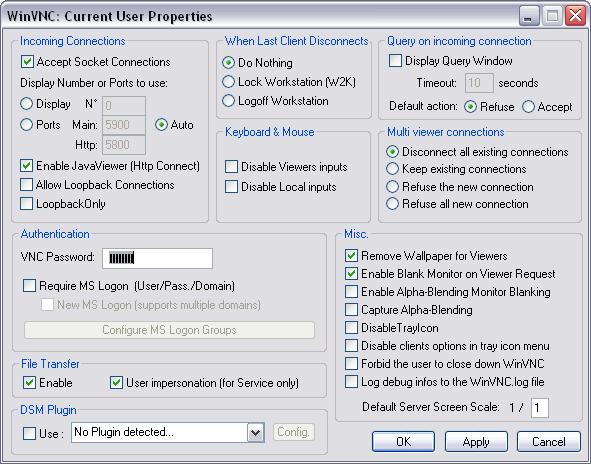

- #ULTRA VNC MIRROR DRIVER INSTALL HOW TO#
- #ULTRA VNC MIRROR DRIVER INSTALL INSTALL#
- #ULTRA VNC MIRROR DRIVER INSTALL SOFTWARE#
- #ULTRA VNC MIRROR DRIVER INSTALL CODE#
INFO: RETURN: DriverPackagePreinstallW (0x800B0110)
#ULTRA VNC MIRROR DRIVER INSTALL CODE#
(Error code 0x800B0110: The certificate is not valid for the requested usage.) INFO: Driver package 'mv2.inf' is Authenticode signed. INFO: mv2.inf: checking signature with catalog 'c:\mv2.cat'. INFO: Found driver package: 'C:\\mv2.inf'.
#ULTRA VNC MIRROR DRIVER INSTALL INSTALL#
INFO: Install option set: Running in quiet mode. INFO: No valid 'dpinst.xml' file provided. INFO: Option set: dumping log info to console. Running it from the Command Prompt as a test gave me an error about the certificate being inappropriate for the requested usage. Next, I thought about using DIFxApp as a Custom Action. (Q2) Any ideas why not? Is it because this a virtual device? The vendor's installer results in the following entry under "Display adapters" but DIFxApp doesn't do the same! inf).Īdditionally, what is more concerning is that the mirror driver virtual device itself, "mv video hook driver2", does not appear in the Device Manager. (Q1) Is this normal behaviour for DIFxApp? (i.e., it does not observe the section in the. This is different from the vendor installer (setupdrv.exe) which drops mv2.dll into %SystemRoot%\system32 and mv2.sys into %SystemRoot%\system32\drivers (which I can see configured in the mv2.inf file). However, even if I was able to somehow suppress this (e.g., I just manually clicked "Continue Anyway" for my testing), the 4 driver files get dropped into and %SystemRoot%\system32\DRVSTORE\mv2_51D59933D8D3C8E541AD493D042293BA1BECE904. Both an interactive or unatteded installation generates the Hardware Installation/Software Installation prompt as above (
#ULTRA VNC MIRROR DRIVER INSTALL HOW TO#
I followed Screenbert's article,, which explains how to package a signed device driver. I have tried using DIFxApp, DPInst, and Devcon to perform driver installation, but they're not giving me the results I'm after. This is not ideal for an unattended enterprise wide deployment. The vendor (UltraVNC) uses a nasty setupdrv.exe file that performs unattended driver installation and prompt suppression by automatically pressing "Continue Anyway" for you - you can see this momentarily pop up on the screen and then disappear.
#ULTRA VNC MIRROR DRIVER INSTALL SOFTWARE#
I guess this means it has not passed "Windows Logo" testing, which is why during installation it generates the annoying Hardware Installation or Software Installation (depending on what you use) prompt: sys files are signed by a GlobalSign issued certificate - not Microsoft.

Inside the 'xp\driver' folder path (XP is the target platform I'm repackaging for), there are 4 files: This will launch the viewer and allow you to input your password and log into the system.Having fun trying to package the UltraVNC Mirror Driver 1.00.22 for use with UltraVNC 1.0.6.4. Once you have run the script to install the viewer onto a target system, you can use the Action dropdown to run it from the main Inventory page, or from the Detail Item page for a given computer. By default, the machine action will be named Action 1, but you can change it to whatever you wish. It should be "C:\Program Files\ultravnc\vncviewer.exe" KACE_HOST_NAMEĬlick Save Actions. This will create a command line to the right of the dropdown menu.Įdit the path in the command line so that it has the explicit path to the viewer. In this example, we are using VNC Remote Control using HOST NAME Click Edit Mode and select the VNC remote option of your choice.

Next, go to Settings>General Settings and scroll down to Machine Actions. Search for UltraVNC in the search box to quickly locate it. Once saved, the script will be found in the Scripts tab.

For a silent install, make sure to leave the Mirror Driver option unchecked. Make sure Install Viewer is selected, and configure your remaining settings as desired. Start by going to the Scripting section and clicking the Configuration Policy tab. The UVNC client wizard will install the viewer on systems that need to be accessed remotely via the Machine Action button in the K1000.


 0 kommentar(er)
0 kommentar(er)
